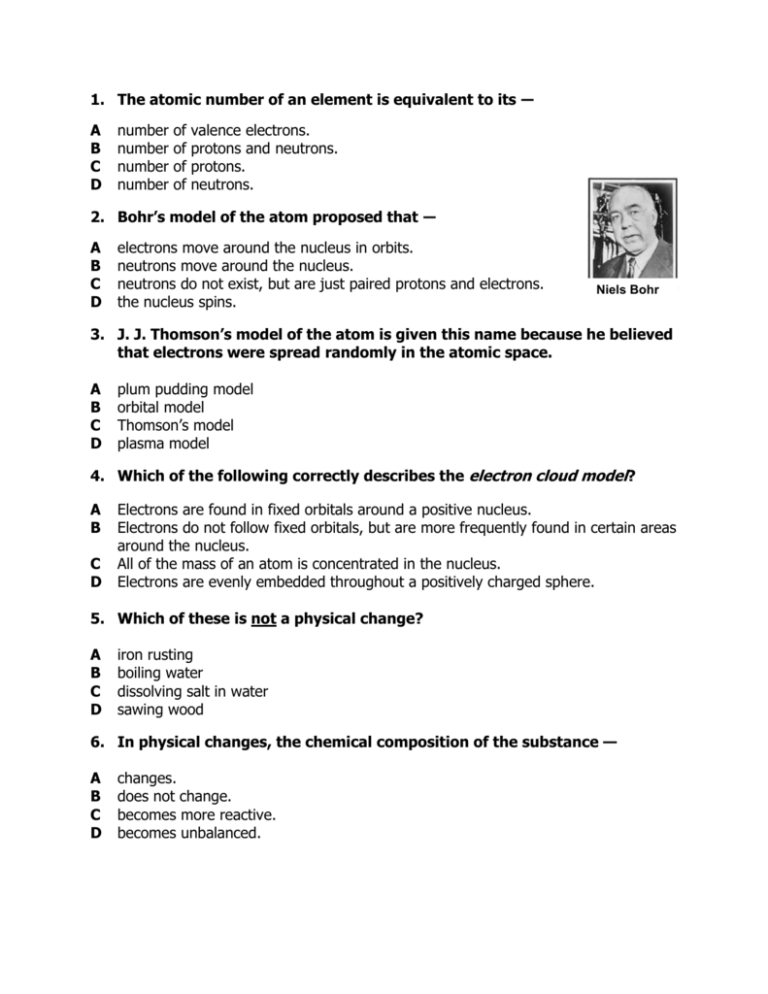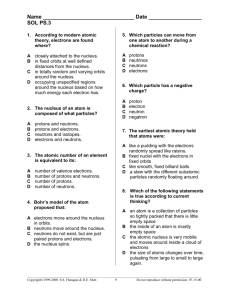PS 3-11
advertisement

1. The atomic number of an element is equivalent to its ― A B C D number number number number of of of of valence electrons. protons and neutrons. protons. neutrons. 2. Bohr’s model of the atom proposed that ― A B C D electrons move around the nucleus in orbits. neutrons move around the nucleus. neutrons do not exist, but are just paired protons and electrons. the nucleus spins. Niels Bohr 3. J. J. Thomson’s model of the atom is given this name because he believed that electrons were spread randomly in the atomic space. A B C D plum pudding model orbital model Thomson’s model plasma model 4. Which of the following correctly describes the electron cloud model? A B C D Electrons are found in fixed orbitals around a positive nucleus. Electrons do not follow fixed orbitals, but are more frequently found in certain areas around the nucleus. All of the mass of an atom is concentrated in the nucleus. Electrons are evenly embedded throughout a positively charged sphere. 5. Which of these is not a physical change? A B C D iron rusting boiling water dissolving salt in water sawing wood 6. In physical changes, the chemical composition of the substance — A B C D changes. does not change. becomes more reactive. becomes unbalanced. 7. Work is done when — A B C D enough effort is exerted on an object. the object on which the force is being applied moves in the direction of the force. someone exerts a great amount of force on an object. forces are balanced. 8. Which of the following is NOT a benefit of using nuclear energy? A B C D There are no waste products left over. There is no air pollution generated. It is a reliable and economical source of energy. It decreases our dependence on foreign oil. 9. The substances to the left of the arrow in a chemical equation are called ― A B C D subscripts. reactants. products. coefficients. 10. Which of the following is a balanced chemical equation for the following reaction? Al+ O2 Al2O3 A B C D 2 Al Al 4 Al 4 Al + 2 O2 2 Al2O3 + 3 O2 2 Al2O3 + O2 4 Al2O3 + 3 O2 2 Al2O3 11. The temperature at which all molecular motion stops is called ― A B C D 0 degrees Celsius. absolute zero. 273 degrees Kelvin. absolute Kelvin. 12. In the winter, salt is often used to melt ice and snow. How does this process work? A B C D The salt is heated by the sun. The heat transfers to the snow and ice, and then melts them. Adding salt causes a heat-releasing chemical reaction, which melts the snow and ice. Adding the salt lowers the freezing point of water below 0 °C, causing the snow and ice to melt. Adding the salt raises the boiling point of water above 0 °C, causing the snow and ice to melt. 13. What type of heat transfer is present when boiling an egg? A B C D convection and radiation vaporization and conduction radiation and vaporization conduction and convection 14. Which of the following is a measure of the average kinetic energy of the particles in an object? A B C D potential energy thermal energy temperature specific heat 15. In which direction does heat move? A B C D from lower temperature matter to higher temperature matter from higher temperature matter to lower temperature matter from matter at one temperature to other matter at similar temperatures in a direction to increase the temperature difference between the groups of matter 16. What happens to temperature during a phase change in a substance? A B C D It increases. It decreases. It can either increase or decrease. It stays the same. 17. Which of these is not a way in which heat is transferred? A B C D conduction convection radiation subduction 18. What is the only type of heat transfer that can take place across a vacuum? A B C D radiation convection conduction No heat transfer can occur through a vacuum. 19. Which of these uses radiation to transfer heat energy? A B C D deep fryer electric grill steam iron electric toaster 20. Sound waves are different from water waves because ― A B C D water waves are mostly transverse, but sound waves are longitudinal. sound waves travel in straight lines. they have different wavelengths. water waves are higher in frequency. 21. A longitudinal wave is different from a transverse wave because ― A B C D energy is transferred from the wave. the particles move back and forth, parallel to the path of the wave instead of at right angles to the path. energy is lost by the wave. it has a longer wavelength. 22. What two things affect the speed of sound? A B C D the the the the medium that the sound travels through and the temperature of the medium distance to the medium that the sound travels through and the size of the wave temperature and the resonance of the medium that the sound travels through compression and rarefaction of the sound waves 23. The amount of work done in a period of time is called ― A B C D force. power. exertion. impetus. 24. What two quantities does the acceleration of a moving object depend on? A B C D the the the the force and the mass of the object force and the velocity of the object friction and the speed of the object resistance and the momentum of the object 25. Suppose you are at an ice-skating rink. You push a flat smooth object forward on the ice with your hand and let go of it, so that it can continue to slide. If the object could slide completely without friction on the ice, how would it move according to Newton’s Laws of Motion? A B C D It It It It would would would would curve curve move move to the left at a constant speed. to the right at a decreasing speed. straight ahead at a constant speed. straight ahead at a decreasing speed. 26. What is the name of the effect of the gravitational force that the Earth exerts on an object? A B C D weight mass velocity acceleration 27. A student lifts a box off the floor, and then walks to the other side of the room. When does the student do work? A B C D when walking across the room when lifting the box both when lifting the box and walking at no time does the student do work 28. Which of these is an example of a compound machine made up of a wedge and a lever? A B C D a see-saw a screw an ax an inclined plane 29. In a series circuit such as the following ― A B C D the devices wired to the circuit always go on and off together. all devices operate at the same voltage. electrons flow on several paths. all elements consume the same amount of power. 30. Which can be used as an insulator? A B C D silver plastic steel copper 31. An electric current, flowing in a wire, generates what type of field? A B C D a gravitational field a magnetic field an electrical field an attraction field 32. Electric current is ― A B C D stronger than static electricity. increased when you increase the voltage. decreased when you increase the voltage. a depletion of electrons. 33. A generator is a device that — A B C D converts mechanical energy into electrical energy converts electrical energy into mechanical energy converts mechanical energy into chemical energy converts nuclear energy into mechanical energy 34. Which substance contains a covalent bond? A B C D KCl N2 Ca2O CuBr 35. Suppose a juggler is juggling bowling pins. At the bowling pin’s highest point, what form of energy does it have? A B C D potential energy kinetic energy no potential or kinetic energy equal amounts of both







